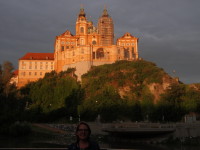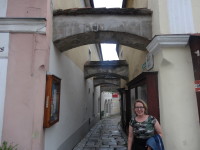 So, after nine days of being in Alpine country, we finally left the mountains behind, heading east toward our eventual destination of Melk, home of a huge (and I do mean huge) abbey. We started off the day in a light but steady rain, but we had a two-hour drive ahead of us, and the rain did stop just as we pulled into our main destination of the day, Mauthausen concentration camp.
So, after nine days of being in Alpine country, we finally left the mountains behind, heading east toward our eventual destination of Melk, home of a huge (and I do mean huge) abbey. We started off the day in a light but steady rain, but we had a two-hour drive ahead of us, and the rain did stop just as we pulled into our main destination of the day, Mauthausen concentration camp.
Mauthausen concentration camp has been partially preserved as a memorial site to those victims who died there, as well as those who survived. There have been some changes in the seventy years since the camp was liberated — most of the external buildings (soldier barracks and administrative buildings) have been torn down, all but four of the prisoner barracks have been torn down, and many countries who had citizens imprisoned in the camp have since put up memorials where the soldier barracks were. Still, the external walls, four of the barracks, the outlines of the other barracks, and the kitchen and laundry buildings all still exist, and the site is free to the public to visit.
A concentration camp may seem like an odd thing to go to while on a sightseeing tour, but since we are both in education, it seemed appropriate as a way to learn more about the very dark side of World War II. I had not even known there was a camp at Mauthausen, but 190,000 people were imprisoned there or in one of its smaller satellite camps, and of those 190,000 people, 90,000 died.
There was a lot to see, and we spent over five hours at the site. We had an excellent audioguide that took us around the camp and explained what we were seeing. There were also three film rooms that showed films about the camp and what happened after the war. Finally, there was an excellent museum that told about how the camp came into being (broad history about the Nazis), as well as day-to-day life in the camp (personal stories including photos, letters, and possessions).
Outside the camp were memorials to many of the victims from various countries. France and Italy included many pictures of victims in their memorials. The socialist Eastern bloc countries tended to be huge and defiant. Slovenia and Spain had smaller, emotional memorials. We did not find any memorial from the U.S., probably because we did not have a large presence in the camp, with only twelve people imprisoned.
In a couple of ways, the camp was a bit different from our typical ideas of concentration camps. For one thing, while some of Mauthausen’s inmates were Jewish, the camp held a number of non-Jewish inmates too, from Soviet POWs to political prisoners from all over Europe. Also, it was mainly a work camp rather than a mass-extermination camp. However, its inmates were treated so badly that many died within a few weeks of arriving at the camp. Initially, the work involved a nearby stone quarry; later in the war, the workers were switched over to work that would aid the war effort more directly. And though Mauthausen had fewer direct killings than some of the other camps, it still had its share, especially toward the end of the war.
There were some uplifting stories told about the camp — stories of prisoners hiding sick men so they would not be shot, and stories of smuggling people in to the main camp to get them out of the holding camp for those who were going to be killed. Overall, though, the tour is a very sobering experience.
 We continued on our way to Melk, getting to our hotel in the evening around 6:30. That left little time for more than supper, although we did sneak in a short walk down to the surprisingly small Danube River. We walked along it for a short ways, stopping by a store to grab some European candy bars before heading back to the hotel.
We continued on our way to Melk, getting to our hotel in the evening around 6:30. That left little time for more than supper, although we did sneak in a short walk down to the surprisingly small Danube River. We walked along it for a short ways, stopping by a store to grab some European candy bars before heading back to the hotel.